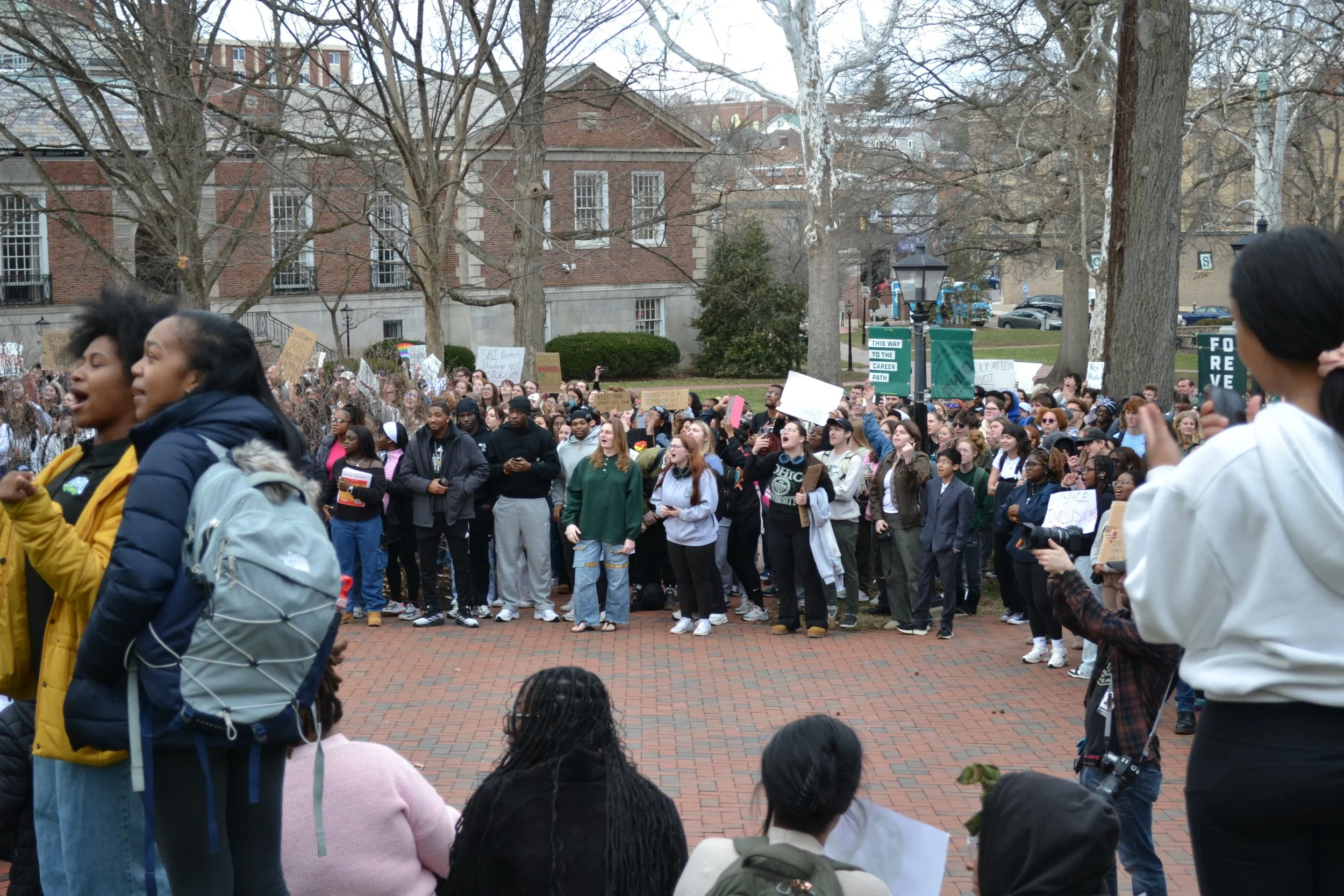Ohio U students protest S.B.1, demand “transparency” from University
Photo via Lillian Franks/The New Political
By: Lillian Franks and Ollie Hunt
This week, Ohio U students turned out to voice opposition to Senate Bill 1 — a recent piece of legislation passed in the Ohio senate targeting diversity, equity and inclusion initiatives in state funded institutions of higher education.
S.B.1, which now awaits a vote in the Ohio House of Representatives, would, among other things, prohibit the existence of DEI offices or departments and the establishment of DEI based scholarships, ban faculty strikes, and require a new course centered around the “study of the American economic system and capitalism.”
The protest, organized by a number of groups and individuals affiliated with Ohio U, including the Black Student Union (BSU), the Black Student Cultural Programming Board (BSCPB), and the Multicultural Student Organization Coalition (MSOC), lasted over two hours and drew crowds that filled the semicircle pavilion outside Cutler Hall.
Ohio U’s current position regarding the legislation was shared in an update posted on the university’s website on Feb 12. But an online flyer circulated on social media by various student groups asserted that “we need to be directly informed of how changes under SB1 and the Department of Education will affect our student life.”
The protest started with a crowd that gathered outside Peden stadium at 1:15 pm Thursday and marched toward College Green in a procession that snaked around Bird ice arena and up Baker Student Center’s escalator. Students carried signs reading “History has its eyes on yOU”, “Silencing diversity = silencing progress,” “Your hate has no place on my campus”, “We demand transparency”, and “Not very ‘make respect visible’ of yOU”, among others.
Aris Miller, an Ohio U student studying social work, held a sign decorated in the pink, blue and white of the transgender flag that read “You cannot legislate us out of existence!”.
“I am the daughter of a transgender woman and a non-binary individual,” Miller said. “This is not new to me. This affects more than the university. It also affects the surrounding community.”
Miller, who has previously volunteered at a drop-in center for adults struggling with mental illness and substance abuse. The clinic’s patients, “some of which are LGBTQ and out, and many of which are LGBTQ and not out, have seen and witness this oppression,” they said. “The university in the past has tried to find that barrier between academia and community and [to help] those who are oppressed,” Miller said.
Holding a sign that read “We will not go back,” Felix Wilson stood beside them. “It’s important to note that we have only just recently come from a place where these things were things we were fighting for,” Wilson said.
Upon arriving at College Green, the crowd listened as members of student groups responsible for organizing the march spoke from the steps leading to Cutler Hall.
“We want to see name our demands here today that we’re looking to see after this, okay?” the first speaker told the crowd.
The demands were as follows:
“We want to see the preservation of supportive structures. We want to see continued commitment to diversity at Ohio University. We want protection against discrimination. We want staffing and funding resources. We want to refrain from overcomplying. This is not a time for convenience. We want protection of academic freedom.
“And last but not least, we want transparency and input from the people who run this university. There’s a reason we’re gathered here today. There’s a reason we gathered in the same spot freshman year four years ago. And to our understanding, the president of this university is in Cutler Hall.
“And we are asking for her to come out and speak to us as the people of this protest who have issues, concerns, and anxiousness about the things that are going on in our government right now.”
Those who followed shared stories of their positive experiences with DEI. One student named FACES Modeling, a fashion based Ohio U student group.
“I came from a very, very diverse high school in Cincinnati Ohio,” the student, who introduced herself as Kylie, said. “But when I came to Ohio University and looked around my journalism classes, and I never saw anyone who looked like me, it was FACES Modeling, my second semester of my freshman year, that instilled the confidence to keep going to this university.”
Another student, who introduced himself as John, asked, “What makes a family great?” to which the crowd responded, “Love!”.
“Is it looking the same? Is it thinking the same? Is it having the same beliefs across the board?” John asked, receiving a loud “No!” from the crowd each time.
Finally, John asked, “Is OU a family?” and received an enthusiastic “Yes!” from the crowd. “What do you do when someone in your family is threatened?” he asked. “Fight back!” voices from the crowd responded.
“My name’s AJ,” another student said before the crowd. “I am a gay person. I’ve always been gay. I was raised in a little town in Illinois, and I was the only one.”
“The reason I [came here] was to leave my hometown and seek a better world. And OU has given me that. I’m gonna be really real now. If it were not for diversity, equity, and inclusion programs, I would be dead,” AJ said.
“Come on Lori, come outside!” one speaker taunted, referring to Ohio University’s President, Lori Stewart Gonzalez. The crowd erupted in chants of “Come outside! Come outside!” as students turned their attention to the upstairs windows of Cutler Hall.
“Lori’s not coming outside. She’s not gonna talk to you today, she’s not gonna talk to you tomorrow,” another speaker said shortly after the crowd had quieted. Calling on students to take their grievances to the state and “get educated,” the speaker explained that “Anger is powerful, but anger is dangerous. But love beats everything.”
By the time the protest’s organizers thanked the crowd and sent those who remained home, nearly two hours had elapsed since the initial gathering outside Peden stadium. “I didn’t think that this many people were gonna be here, but I’m so happy that a lot of people came, or at least came for the time that they could come,” Ariana Villagas, a sophomore, said.

